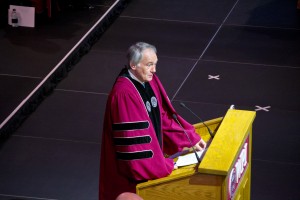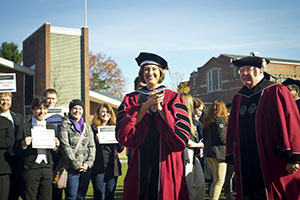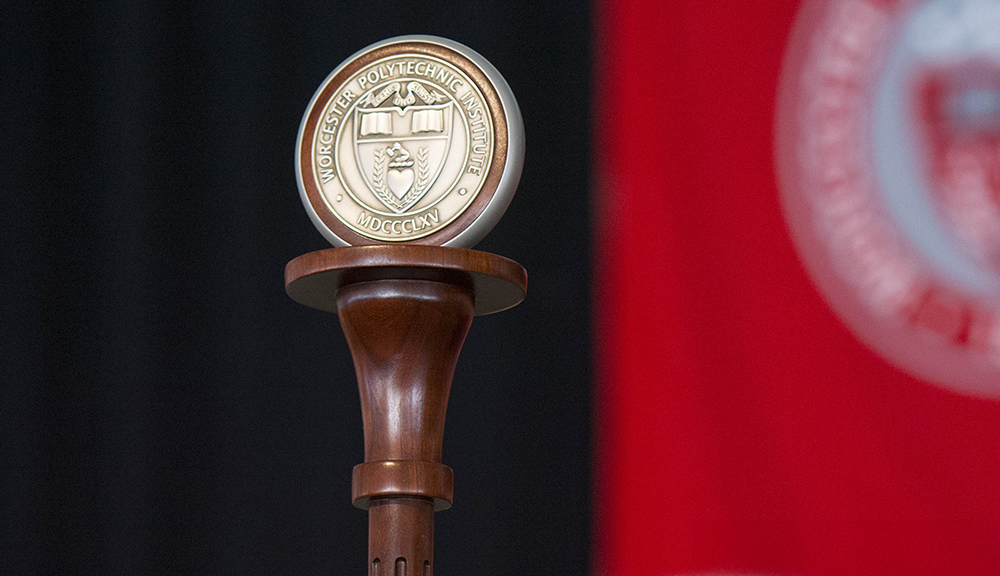
Laurie A. Leshin, WPI’s 16th president
Laurie A. Leshin was formally installed as the 16th president of WPI Saturday in a two-hour inaugural ceremony in the Sports and Recreation Center that drew an audience of 1,500 who heard praise for the university from academic, political, and business leaders, in addition to hearing Leshin’s vision for the future.
The space-inspired program was kicked off by a procession from the Rubin Campus Center led by faculty marshal and WPI provost Eric Overström and the ROTC Color Guard. They were followed by President Leshin, the six Presidential Medal recipients, delegates from more than 70 colleges, universities, and learned societies, as well as WPI faculty and academic department heads. The brick walkways of the Quad were lined by faculty, students, and friends as the procession wound its way into the Sports and Recreation Center.
Philip B. Ryan, former interim president and chairman of the Board of Trustees, acted as master of ceremonies, introducing those to be honored, musical performances the program’s speakers. Among the speakers was U.S. Sen. Edward Markey, who recalled visiting the campus during his senate campaign last year to receive the endorsement of former president Bill Clinton.
“President Leshin, I am thrilled that you are leading this wonderful institution,” he said. “Next year WPI will celebrate its 150th year. What a message this sends to all our promising young women, to see this engineering and technology powerhouse led by a brilliant woman.”
Markey said that only a couple of weeks ago he visited WPI and toured the robotics lab with fellow Democrat U.S. Rep. James McGovern, where they learned of the potential for using robots to work in Ebola hotspots in Africa, as well as other potentially useful applications of WPI technologies.
“At President Leshin’s request, I have asked the Obama Administration to establish a Center of Excellence for first responder technology within the Department of Homeland Security, and to name WPI as the lead institution in the United States of America,” he said, to rousing applause.
During a video in which students at several of WPI’s project centers voiced their best wishes to the new president, the scene shifted to outer space, where NASA Astronaut Reid Wiseman sent congratulations from his post aboard the International Space Station, concluding with a “Woo hoo!” and turning a slow, weightless backflip. President Leshin is both a former NASA administrator and a self-proclaimed “space nerd.”

U.S. Sen. Edward Markey
During her stint at the podium, Leshin presented the WPI Presidential Medal to Barbara Barrett, chairman of the Aerospace Corp. and former U.S. Ambassador to Finland; Tarek Al-Shawaf ‘55, founder and chairman of Saudconsult, the largest private engineering and architectural company in Saudi Arabia; Mariko Silver, president of Bennington College; Subra Suresh, former director of the National Science Foundation and president of Carnegie Mellon University; Wanda Austin, president and CEO of the Aerospace Corp.; and Craig Barrett, former CEO of Intel.
In addition to receiving her medal, Barrett offered her own comments, saying that solutions developed by WPI will help determine the future of the planet.
From curing disease to protecting the environment to securing our national defense to alleviating poverty – the world looks to universities like WPI for ideas and leadership, for intellect matched by character, theory matched by practice, and for both the microscope and the telescope,” she said.
“Just over a hundred years ago, these halls were walked by Robert Goddard, the father of modern rocketry. One hundred years from now, people will remark that WPI was the home of President Laurie Leshin.”
In turn, Leshin lauded the women pioneers who have joined WPI over the last decades.
“If you visit the president’s office webpage, you will see images of all of WPI’s presidents beginning with Charles O. Thompson in 1865,” she said. “Fifteen presidents later, it ends with a picture that looks a little different from all the others—and it’s not just because I don’t have muttonchops. I will admit that it is striking to see my portrait next to the other WPI Presidents for many reasons, but I am deeply honored to join their ranks, and to be the first woman to serve as president of WPI.”
WPI’s women pioneers
The president singled out Lesley Small Zorabedian, the first woman to earn an undergraduate degree from WPI in 1972; Barbara Murphy, the first woman faculty member at WPI; Maryann Bagdis, now Mary Ann Goebel, WPI’s first female student; Jo Ann Manfra, a historian and the first female faculty member to earn tenure at WPI; and Judy Nitsch, the first WPI alumna elected to the board of trustees.


